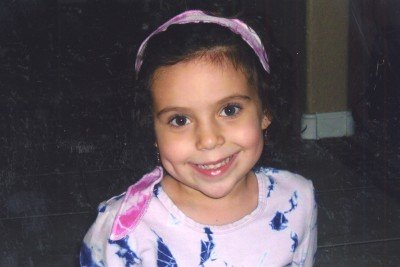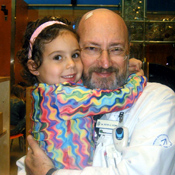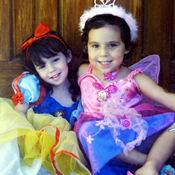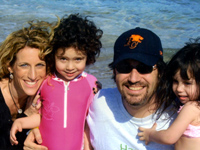Victoria’s Story
After a birthday party, three-year-old Victoria had such a terrible stomach ache that her pediatrician thought it might be appendicitis. X-rays taken before surgery revealed something far worse: stage IV Wilms’ tumor – a type of kidney cancer – that had ruptured and had already spread to other organs. Her parents flew with Victoria from Phoenix to New York City, where at Memorial Sloan Kettering she received surgery and radiation therapy.

Victoria, who was three-and-a-half years old, had been complaining of a stomach ache. Because she appeared fine, Victoria’s mother, Pamela, let Victoria go to school. The following weekend, Victoria went to a friend’s birthday party at a children’s play center, where she joined the other kids playing on the slides and in the jumping pits. Later that night, she woke crying, complaining of another stomach ache. When the pain was still present on Monday morning, Pamela assumed it was probably a stomach virus. “Because you never in your wildest dreams imagine it’s going to be cancer,” she says.
With Victoria’s father, Larry, out of town on business, Pamela took Victoria to the pediatrician that afternoon. By the time they reached the doctor’s office, Victoria was bent over in pain. Instead of stomach flu, Victoria’s pediatrician suspected that she might be suffering from appendicitis. The doctor sent Victoria and her mom to their local Phoenix hospital.
At the hospital, the emergency room doctor recommended that they remove Victoria’s appendix immediately, noting that when it came to appendicitis, he preferred to be aggressive in treatment. Knowing that acute appendicitis is usually accompanied by fever and vomiting — and Victoria had neither of these symptoms — Pamela wasn’t quite so sure. After some quick telephone conversations with physician friends, Pamela asked if the hospital staff could do some scans before operating. The doctor agreed.
“Your Daughter Has a Tumor”
Pamela, who was standing with Victoria during the scans, could see the technician through a small window separating the control room from the scanning bed. “The look on his face was something that is difficult for me to think about even now, more than a year later,” Pamela recalls with evident emotion. When Pamela went to talk to the technician after the scans were completed, he seemed shaken and said that she needed to speak with their doctor.
Knowing this was not a good sign, she immediately called Larry, who was in Connecticut for a job interview. She had him on her cell phone when the emergency room doctor broke the bad news. Pamela will never forget his words: “Your daughter has a tumor.” She was so stunned that Larry, still on the phone, had to ask if the tumor was cancer. The doctor confirmed that it was.
Pamela could not meet with an oncologist until the following morning, so that very afternoon she convened a meeting with a number of their physician friends, the ER doctor, and the pediatric surgeon on-call at the time. With the help of their friends, Pamela and Larry began to ask more specific questions about Victoria’s condition.
“They suggested questions that we didn’t know to ask,” Pamela says. “And that’s when we learned it was stage IV Wilms’ tumor and that the tumor had ruptured.”
(Named for Max Wilms, the surgeon who first identified the disease in 1899, Wilms’ tumor is a disease in which cancerous cells grow in one or both of the kidneys. Stage IV tumors are those that have spread beyond the kidney’s vicinity into other organs.)
The information Pamela supplied led the doctors to believe that the tumor had ruptured at the birthday party, and the pain was caused by the ruptured tumor bleeding into Victoria’s abdomen. To make matters even more complicated, Pamela and Larry also had Victoria’s 18-month-old sister Phoebe to care for.
The Longest Night
“I was obviously in shock,” Pamela says. “You wake up in the morning figuring your child has a stomach virus and 12 hours later you find out she has a rare disease in an advanced stage.”
Larry went immediately to the airport in New York, where he had to wait overnight for the next available flight. “It was the longest night of my life,” he says. “The only thing I know is that my daughter has this cancerous tumor and that it has supposedly metastasized to her lungs. All I could think about was that I was 2,500 miles away and I needed to get home.”
Victoria was admitted to the local children’s hospital, still in a great deal of pain, which was kept in check with morphine. Wondering how much they should tell Victoria about her condition, Pamela met with a child psychologist, who counseled honesty and to use language that a three-year-old would understand. “I explained to Victoria that she was sick, but that we were going to take care of her and she would get better,” Pamela notes.
More Bad News Softened by a Ray of Hope

Victoria with Dr. Steinherz
The tumor was growing around the vena cava, the two large veins that collect blood from the rest of the body and return it to the heart. The danger was that the tumor would invade the vena cava, at which point it could travel to the heart; from there it might spread to the rest of the body.
Within 48 hours, a surgeon from the pediatric hospital performed exploratory surgery. Unfortunately, due to the rupture, the tumor was dispersed throughout the abdomen in a thin, tissue-paper consistency and could not be easily removed. A tissue sample was taken during the surgery and the Whites had to wait two days for the results, which would determine whether Victoria’s tumor was of favorable or unfavorable histology — meaning if it would or would not respond to treatment.
Finally, they received one piece of good news: Victoria’s tumor had a favorable histology. As a result, the Phoenix doctors wanted to treat her initially with six to 12 weeks of chemotherapy, in order to shrink the tumor before surgically removing it.
Second Opinion and Change of Mind
Victoria began chemotherapy in Phoenix. During this time, Larry — wanting to explore all options, and on the advice of a number of physicians and Pamela’s immediate family — traveled to New York to meet with the Wilms’ tumor team at Memorial Sloan Kettering Cancer Center.
“The advice of all our physician friends combined with everything we read made it clear that for this type of advanced, rare cancer, it was critical to find a surgeon who had removed more of these types of tumors than anyone else,” Larry explains.
And the names that kept coming up were Memorial Sloan Kettering’s Michael La Quaglia, a pediatric surgeon specializing in the treatment of Wilms’ tumor, and Peter Steinherz, a pediatric hematologist and oncologist who also specializes in the disease.
When Larry met with them, Dr. Steinherz recommended that the tumor, which was aggressive and fast-growing, should be removed immediately. “Dr. Steinherz opened my eyes,” Larry says. “He questioned leaving the tumor in Victoria for another 12 weeks.” Dr. La Quaglia agreed, reassuring Larry that it could be surgically removed.
The eventual decision to come to Memorial Sloan Kettering was not difficult. As Larry puts it, “We never wanted to be in the position where we second-guessed the care we got for our child. How could we not choose Memorial, when everyone was saying they were the best?”
“When She’s on the Operating Table, She’s My Daughter”

Victoria at Halloween with her younger sister Phoebe
The following Saturday, the whole family flew to New York City for a five-week stay. A CT scan found that the initial chemotherapy Victoria had undergone had shrunk her tumor by two-thirds.
Surgery was performed without delay on December 21. Larry, wearing scrubs, was allowed to carry Victoria into the operating room. Before he left, Dr. La Quaglia reassured him, saying, “When she’s on the operating table, she’s my daughter.”
During the procedure, Dr. La Quaglia had to remove part of Victoria’s liver, diaphragm, and kidney. One week after surgery, under the guidance of Kathryn Beal, a Memorial Sloan Kettering radiation oncologist, Victoria began radiation therapy to kill any remaining tumor cells, especially those that had spread to her lungs.
On January 25, a little more than a month after her surgery, Victoria was able to go home. Pamela was initially hesitant but Dr. Steinherz encouraged the move, saying that half the battle would be Victoria’s attitude, which would greatly improve once she was back in her normal routine. However, she would have to continue chemotherapy in Phoenix as part of the treatment protocol.
Thank You Note
Having weighed 36 pounds at the time of the Wilms’ tumor diagnosis three months earlier, she now weighed 27 pounds. “When we celebrated Victoria’s birthday on February 19, she had lost most of her hair and just looked sick,” remembers Pamela. Still, to show their thanks, Pamela took a number of pictures at Victoria’s party and sent them to Dr. La Quaglia, Dr. Steinherz, and Dr. Mark Kayton, another pediatric surgeon involved in Victoria’s care. “I wrote and told them — and I truly meant it — that we wouldn’t have this day of celebration if it weren’t for their efforts,” Pamela adds.
By the beginning of March, Victoria was beginning to recover her pretreatment energy and spirit, slowly returning to the gregarious, energetic little girl she had been before. And only seven weeks after surgery, as a testament to her indomitable spirit, she returned to school and to her dance classes. “It was important for her to put her leotard on and dance again,” Larry explains.
On March 22, they went in for another CT scan, requested by Dr. Steinherz to check on Victoria’s progress. The Whites held their breath. “This was a tough one for us because we wanted to make sure that Victoria was still responding,” Larry says. “We then received the greatest news possible: the scans showed no trace of cancer.” Larry recalls the sense of physical relief that the news brought: “I remember writing in my journal that this was the first time in four or five months that we actually could exhale.”
Dr. “Steinhearts,” Dr. LaQuaglia, and Dr. Kayton — the Rock

Pamela, Victoria, Larry, and Phoebe on a recent vacation
Victoria received her last chemotherapy treatment on May 3 and her last radiation treatment — intended to remove any remaining tumor cells in her lungs — at Memorial Sloan Kettering at the end of May. By this time, she had no side effects from the radiation treatment and little change to her reenergized personality. “She loves New York City now,” Pamela says, laughing. “She loves going to Sloan Kettering because, as she says, ’that’s where they made me better.’” In fact, in honor of the effect that he and his care had on her well-being, Victoria now refers to Dr. Steinherz as “Dr. Steinhearts.”
In Pamela’s opinion, Dr. Steinherz, Dr. LaQuaglia, and Dr. Kayton are like rock stars. “They are some of the most important people in our lives because they saved our daughter,” she says with matter-of-fact conviction.
On February 19, 2007, Victoria celebrated both her fifth birthday and her fourth consecutive cancer-free CT scan. Displaying her usual infectious spirit at the birthday bash, surrounded by school friends and parents, she was truly the queen of the show, wearing a crown and a never-ending smile. Everyone agreed that this was not just another birthday but one to be specially savored.
Advice for Other Families
When asked for any advice they might have for other families going through the initial stages of a cancer diagnosis with their children, Pamela and Larry quickly respond with a number of suggestions: “Get multiple opinions. Go to a comprehensive cancer center. And don’t be afraid to ask your doctor any question that you have.”
“And never be in a position where you second-guess yourself after deciding where to seek treatment for your child,” Larry adds. “For us, the choice was simple: Memorial Sloan Kettering. It was the best decision we have ever made.”

